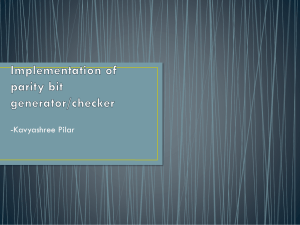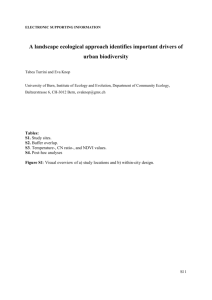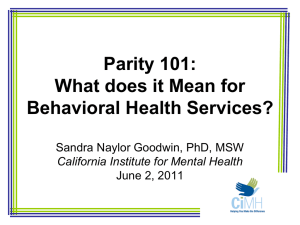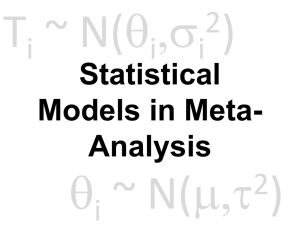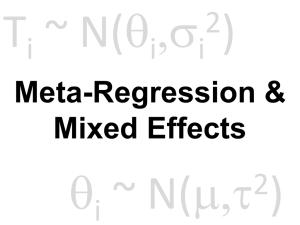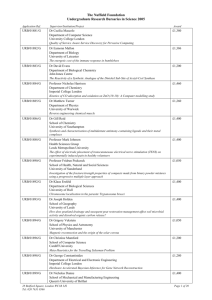Single and Multiple Spell Discrete Time Hazards Models with
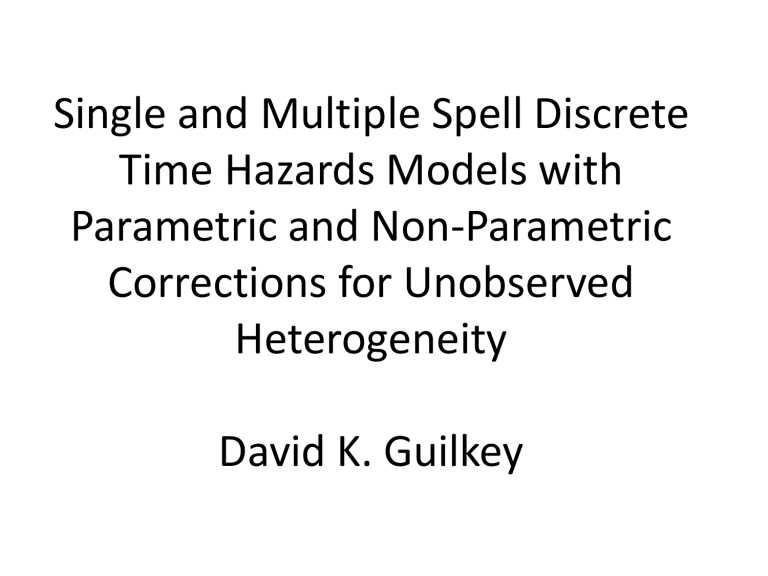
Single and Multiple Spell Discrete
Time Hazards Models with
Parametric and Non-Parametric
Corrections for Unobserved
Heterogeneity
David K. Guilkey
Demographic Applications:
Single Spell
1. Time until death
2. Time until retirement
3. Time until first marriage
4. Time until first birth
Multiple Spell
1. Time until birth of each child
2. Duration of each spell of employment
We will use time until first birth and the timing of subsequent births as an example throughout the presentation.
The variable of interest is: P(t ≤ T < t+n | T > t)
This is the conditional probability that an individual experiences the event between t and t+n given that she has not experienced the event until that time.
Example:
The dependent variable is the timing of a first birth. Suppose the discrete time interval is a year and we observe each woman from the beginning of her child bearing years:
0…..1…..2…..3
Consider three cases:
Person 1: Has a birth in year 1 (time 0 may be age 12)
Person 2: Has a birth in year 2
Person 3: Still has not had a birth at the end of the observation period
Some important notes:
1. Since we are following the woman from the beginning of her child bearing years, we have eliminated the possibility of left censoring (the event occurs before the observation period).
2. Left censoring combined with unobserved heterogeneity introduces bias into the estimation results. The correction requires the estimation of an “initial conditions” equation similar to Heckman selection equation which are well known to yield unstable parameter estimates.
3. The third person is right censored. However, right censoring is easily handled as part of the estimation process.
4. As will be seen below, the dependent variable in a discrete time hazard model is dichotomous. Can use probit, logit or complementary log log (cloglog) models. Logit and cloglog are most often used. I use logit since one of the software packages needs logit – results were nearly the same for cloglog in models where software allowed for both
(STATA).
The model:
Person 1 (birth occurs in the first interval): ln
P Y
11
1)
P Y
11
0)
X
11
1
Which leads to:
P Y
11
e X
1
e X
Person 2 (No birth in the first year and a birth in the second year): ln
P Y
12
1)
P Y
12
0)
X
12
1 ln
P Y
22
1| Y
12
0)
P Y
22
0 | Y
12
0)
X
22
2
Joint probability is:
P Y
22
1, Y
12
0)
P Y
22
1| Y
12
P Y
12
0)
e X
22
2
1
e X
22
2
1
1
e X
Person 3: (No births in the observation period)
P Y
33
0, Y
23
0, Y
13
0)
1
1
e X
33
3
1
1
e X 1
1 e X
Estimation:
Time 1: 3 observations
Time 2: 2 observations
Time 3: 1 observation
The three sets of coefficients could be estimated in three separate logits for the set of individuals at risk. This is true since there is no unobserved heterogeneity that links the three time periods together.
Duration dependence
This is a concept similar to state dependence in a standard panel data model.
Duration dependence occurs when the value of the hazard at any point in time depends on the amount of time that has already elapsed.
Relates to the propensity of a state towards self-perpetuation
Examples:
Mortality – hazard increases with time regardless of the values of the other covariates
Unemployment duration – hazard of finding employment may decrease as the length of the unemployment spell increases
Modeling Duration Dependence
In our current model, duration dependence is captured by the intercept terms in the equation since they are allowed to differ at each point in time.
To see more clearly, assume that the effects of the covariates is the same at each point in time (the β’s are the same in the previous equations).
Now define T
1ti
=1 if if t=1 and 0 otherwise – with T
2ti similarly and T
3ti defined
Then we can write (no constant in the model): ln
( ti
1| Y t
1, i
P Y ti
0 | Y t
1, i
0
0
X ti
T
1 1 ti
T
2 2 ti
T
3 3 ti
Which allows for a very flexible pattern of duration dependence – can be non-linear for example
A less flexible pattern that requires the estimation of fewer parameters is: ln
( ti
1| Y t
1, i
P Y ti
0 | Y t
1, i
0
0
X ti t
In our example, we will be examining the birth hazard starting all women at age 10 and so age and duration dependence are not separately identified.
A parametric model which allows for non-linear duration dependence is: ln
( ti
1| Y t
1, i
P Y ti
0 | Y t
1, i
0
0
X ti
1 t
2 t 2
Empirical Example
Data from Indonesia Family Life Survey.
We first examine timing of first birth – women followed from age 10 until first birth.
Data set up: personid yrcal
1002 63
1002
1002
64
65
1002
1002
1002
1003
1003
1003
1003
66
67
68
67
68
69
70
1003
1003
1003
1003
1003
1003
1003
74
75
76
77
71
72
73
1
0
0
0
0
0
0 conce
0
0
0
0
1
0
0
0
0
0
13
14
15
10
11
12
13 age
10
11
12
17
18
19
20
14
15
16
Simple Models (linear and non-linear duration dependence): logit conce urb age yrsinsch
Logistic regression Number of obs = 50115
LR chi2(3) = 1750.39
Prob > chi2 = 0.0000
Log likelihood = -14109.13 Pseudo R2 = 0.0584
------------------------------------------------------------------------------
conce | Coef. Std. Err. z P>|z| [95% Conf. Interval]
-------------+----------------------------------------------------------------
urb | -.2801102 .0341458 -8.20 0.000 -.3470347 -.2131856
age | .1079184 .0025615 42.13 0.000 .102898 .1129388
yrsinsch | .0025478 .0041978 0.61 0.544 -.0056798 .0107754
_cons | -4.084346 .0519202 -78.67 0.000 -4.186107 -3.982584
------------------------------------------------------------------------------
Logistic regression Number of obs = 50115
LR chi2(4) = 4098.82
Prob > chi2 = 0.0000
Log likelihood = -12934.914 Pseudo R2 = 0.1368
------------------------------------------------------------------------------
conce | Coef. Std. Err. z P>|z| [95% Conf. Interval]
-------------+----------------------------------------------------------------
urb | -.2597377 .0347479 -7.47 0.000 -.3278422 -.1916331
age | 1.044837 .0264714 39.47 0.000 .9929543 1.09672
age_sq | -.0219638 .0006486 -33.87 0.000 -.023235 -.0206927
yrsinsch | -.0448548 .0041327 -10.85 0.000 -.0529547 -.0367549
_cons | -13.08654 .2603383 -50.27 0.000 -13.59679 -12.57628
------------------------------------------------------------------------------
Non-parametric Duration Dependence (using duration or age dummies):
Logistic regression Number of obs = 50115
LR chi2(22) = 4198.03
Prob > chi2 = 0.0000
Log likelihood = -12885.309 Pseudo R2 = 0.1401
------------------------------------------------------------------------------
conce | Coef. Std. Err. z P>|z| [95% Conf. Interval]
-------------+----------------------------------------------------------------
urb | -.2558662 .0346786 -7.38 0.000 -.3238349 -.1878975
agedum1 | -4.966854 .587953 -8.45 0.000 -6.119221 -3.814487
agedum2 | -2.098861 .1787642 -11.74 0.000 -2.449232 -1.748489
agedum3 | -1.773665 .1644908 -10.78 0.000 -2.096061 -1.451269
agedum4 | -1.262905 .1467448 -8.61 0.000 -1.550519 -.9752901
agedum5 | -.6653681 .1331233 -5.00 0.000 -.926285 -.4044513
agedum6 | -.1173774 .1256073 -0.93 0.350 -.3635632 .1288084
agedum7 | .235519 .1228915 1.92 0.055 -.0053439 .476382
agedum8 | .6506007 .1207185 5.39 0.000 .4139968 .8872045
agedum9 | .8665138 .1209088 7.17 0.000 .6295368 1.103491
agedum10 | 1.034363 .121797 8.49 0.000 .7956458 1.273081
agedum11 | 1.171486 .1234081 9.49 0.000 .9296107 1.413361
agedum12 | 1.182254 .1267102 9.33 0.000 .9339064 1.430601
agedum13 | 1.373427 .1289028 10.65 0.000 1.120783 1.626072
agedum14 | 1.381945 .1340668 10.31 0.000 1.119179 1.644711
agedum15 | 1.419845 .1399481 10.15 0.000 1.145552 1.694138
agedum16 | 1.18434 .1526529 7.76 0.000 .8851458 1.483534
agedum17 | 1.330018 .15859 8.39 0.000 1.019187 1.640848
agedum18 | 1.191952 .174294 6.84 0.000 .8503424 1.533562
agedum19 | .855728 .2002908 4.27 0.000 .4631651 1.248291
agedum20 | .6546571 .2260183 2.90 0.004 .2116694 1.097645
yrsinsch | -.0438339 .004139 -10.59 0.000 -.0519462 -.0357216
_cons | -2.157563 .1115451 -19.34 0.000 -2.376188 -1.938939
------------------------------------------------------------------------------
Duration Dependence and Unobserved Heterogeneity
Review of dynamic panel data model:
Yti
i
ti where we have a time varying error and a persistent error (sometimes referred to as time invariant unobserved heterogeneity)
Define:
Then: cor Y Y ti t
1, i
)
2
Alternative model (state dependence):
Y ti
Y t
1, i ti where |α|<1
Now: ti t
1, i
)
It is very difficult to distinguish between the models – so we use the hybrid model:
Y ti
Y t
1, i
i
ti
A problem is that this model is more difficult to estimate – neither ordinary least squares nor fixed effects methods yield consistent estimators – use maximum likelihood (with initial conditions problem) or instrumental variables.
Return to first example and unobserved heterogeneity (using person 2 as the example):
Person 2 (No birth in the first year and a birth in the second year): ln
P Y
12
1|
2
)
P Y
12
0 |
2
)
X
12
1
2 ln
P Y
22
1| Y
12
0,
2
)
P Y
22
0 | Y
12
0,
2
)
X
22
2
2
We can no longer estimate parameters time period by time period – due to selection on unobservables (just as in standard Heckman selectivity model)
Joint probability is now:
(
22
1, Y
12
0 |
2
)
e X
22
2
1
e X
22
2
1
1
e X
2
The unconditional joint probability is:
P Y
22
1, Y
12
0)
P Y
22
1, Y
12
0 |
2 f
2
) d
2
Most commonly used distributional assumption for the unobserved heterogeneity is the normal distribution. The integral is approximated using Hermite point and weights (simply looked up in a table for the normal distribution):
P Y
22
1, Y
12
0)
k
K
1 w P Y k 22
1, Y
12
0 | h k
)
K is the number of interpolation points – more accurate to add more but slower (STATA default is 12 – frequently not enough for rare events)
Heckman-Singer approach: Do not assume a distribution – directly estimate the points and weights as part of the maximum likelihood estimation process – referred to as the discrete factor approximation.
Identification
“it is somewhat heroic to think that we can distinguish between duration dependence and unobserved heterogeneity when we only observe a single cycle for each agent” (Wooldridge – page
705)
Example:
Model with no censoring estimated by OLS.
Can identify both using functional form – but the model parameter estimates are frequently unstable.
Examples
Assume normality:
. xtlogit conce urb age age_sq yrsinsch,i(personid) intp(20)
Random-effects logistic regression Number of obs = 50115
Group variable: personid Number of groups = 4659
Random effects u_i ~ Gaussian Obs per group: min = 1
avg = 10.8
max = 40
Wald chi2(4) = 252.90
Log likelihood = -12767.616 Prob > chi2 = 0.0000
------------------------------------------------------------------------------
conce | Coef. Std. Err. z P>|z| [95% Conf. Interval]
-------------+----------------------------------------------------------------
urb | -.8368256 .1328742 -6.30 0.000 -1.097254 -.576397
age | 3.508179 .2292176 15.31 0.000 3.05892 3.957437
age_sq | -.0544224 .0035137 -15.49 0.000 -.0613092 -.0475356
yrsinsch | -.4246292 .0365909 -11.60 0.000 -.4963459 -.3529124
_cons | -44.2749 2.861672 -15.47 0.000 -49.88368 -38.66613
-------------+----------------------------------------------------------------
/lnsig2u | 3.424721 .1417704 3.146856 3.702585
-------------+----------------------------------------------------------------
sigma_u | 5.542027 .3928477 4.823153 6.368046
rho | .9032504 .0123892 .8761003 .9249606
------------------------------------------------------------------------------
Likelihood-ratio test of rho=0: chibar2(01) = 334.60 Prob >= chibar2 = 0.000
Cannot directly compare the coefficients with and without heterogeneity correction because of possible scale differences for discrete dependent variable models. However, scale effects can be removed if you compare ratios of coefficients:
Without unobserved heterogeneity:
Age
Education
1.04
0.04
26.00
With Unobserved heterogeneity:
Age
Education
3.51
0.42
8.36
Use Discrete Factor Method
. gllamm conce urb age age_sq yrsinsch,i(personid) family(binomial) link(logit) nip(3) ip(f) trace dot number of level 1 units = 50115 number of level 2 units = 4659
Condition Number = 6445.9732 gllamm model log likelihood = -12719.097
------------------------------------------------------------------------------
conce | Coef. Std. Err. z P>|z| [95% Conf. Interval]
-------------+----------------------------------------------------------------
urb | -.4086555 .0536189 -7.62 0.000 -.5137466 -.3035643
age | 1.022321 .0402732 25.38 0.000 .9433868 1.101255
age_sq | -.0156502 .0009014 -17.36 0.000 -.0174168 -.0138836
yrsinsch | -.1584645 .0086805 -18.26 0.000 -.1754779 -.1414511
_cons | -14.04514 .4201875 -33.43 0.000 -14.86869 -13.22158
------------------------------------------------------------------------------
Probabilities and locations of random effects
------------------------------------------------------------------------------
***level 2 (personid)
loc1: -4.494, -1.0551, .89329
var(1): 2.0312478
prob: 0.0588, 0.296, 0.6453
Multiple Spell Discrete Time Hazards Models
Model with no unobserved heterogeneity:
Allow for M births: ln
P Y tim
1| Y t
1, im
P Y tim
0 | Y t
1, im
0,
0, births m births m
1
1
X tim
m
1 t m m
2 t m m
2
With no heterogeneity, estimate M+1 single spell hazards models
(or fully interacted model).
Results for fully interacted model (m=0,1,2,3,4):
logit conce parity_0 urb_0 age_0 age_sq_0 yrsinsch_0 parity_1 urb_1 age_1 age_sq_1 yrsinsch_1 parity_2 urb_2 age_2 age_sq_2 yrsinsch_2 parity_3 urb_3 age_3 age_sq_3 yrsinsch_3
> parity_4 urb_4 age_4 age_sq_4 yrsinsch_4,nocons
Logistic regression Number of obs = 101157
Wald chi2(25) = 31743.59
Log likelihood = -35873.982 Prob > chi2 = 0.0000
------------------------------------------------------------------------------
conce | Coef. Std. Err. z P>|z| [95% Conf. Interval]
-------------+----------------------------------------------------------------
parity_0 | -13.0865 .2603375 -50.27 0.000 -13.59676 -12.57625
urb_0 | -.2597377 .0347479 -7.47 0.000 -.3278422 -.1916331
age_0 | 1.044834 .0264713 39.47 0.000 .9929509 1.096716
age_sq_0 | -.0219637 .0006486 -33.87 0.000 -.0232349 -.0206926
yrsinsch_0 | -.0448548 .0041327 -10.85 0.000 -.0529547 -.0367549
parity_1 | -3.542908 .3506967 -10.10 0.000 -4.23026 -2.855555
urb_1 | .1140113 .0407575 2.80 0.005 .0341281 .1938945
age_1 | .2507085 .0302698 8.28 0.000 .1913807 .3100363
age_sq_1 | -.0062789 .0006319 -9.94 0.000 -.0075174 -.0050403
yrsinsch_1 | -.0006391 .0050614 -0.13 0.900 -.0105593 .0092811
parity_2 | -3.061192 .4668261 -6.56 0.000 -3.976155 -2.14623
urb_2 | .0445203 .046588 0.96 0.339 -.0467904 .1358311
age_2 | .2043045 .0367711 5.56 0.000 .1322346 .2763745
age_sq_2 | -.0053638 .0007064 -7.59 0.000 -.0067484 -.0039792
yrsinsch_2 | -.0152708 .0060049 -2.54 0.011 -.0270402 -.0035013
parity_3 | -3.860511 .677871 -5.70 0.000 -5.189114 -2.531909
urb_3 | .0284173 .0568567 0.50 0.617 -.0830197 .1398543
age_3 | .2695803 .0493892 5.46 0.000 .1727792 .3663814
age_sq_3 | -.0065998 .0008828 -7.48 0.000 -.00833 -.0048696
yrsinsch_3 | -.029156 .0077006 -3.79 0.000 -.0442488 -.0140632
parity_4 | -3.382981 .9368919 -3.61 0.000 -5.219256 -1.546707
urb_4 | .0550487 .0717479 0.77 0.443 -.0855747 .195672
age_4 | .2516846 .0645228 3.90 0.000 .1252223 .3781469
age_sq_4 | -.0063117 .001094 -5.77 0.000 -.0084558 -.0041676
yrsinsch_4 | -.0403808 .0099802 -4.05 0.000 -.0599416 -.02082
------------------------------------------------------------------------------
Simple Model with coefficients restricted to be the same (using all available births for all women):
. logit conce urb age age_sq yrsinsch parity
Logistic regression Number of obs = 113995
LR chi2(5) = 7363.66
Prob > chi2 = 0.0000
Log likelihood = -41237.438 Pseudo R2 = 0.0820
------------------------------------------------------------------------------
conce | Coef. Std. Err. z P>|z| [95% Conf. Interval]
-------------+----------------------------------------------------------------
urb | -.0696638 .0191482 -3.64 0.000 -.1071936 -.0321341
age | .6257251 .0092857 67.39 0.000 .6075256 .6439246
age_sq | -.0127468 .0001916 -66.51 0.000 -.0131224 -.0123712
yrsinsch | -.0275519 .0024491 -11.25 0.000 -.0323521 -.0227518
parity | .0479533 .0065391 7.33 0.000 .0351368 .0607697
_cons | -8.751946 .1082908 -80.82 0.000 -8.964192 -8.5397
------------------------------------------------------------------------------
Add unobserved heterogeneity to the model: ln
P Y tim
1| Y t
1, im
P Y tim
0 | Y t
1, im
0,
0, births m births m
1
1
X tim
m 1 t m m
2 t m m
2
mi
In order to use STATA, must assume a restrictive form of unobserved heterogeneity for both parametric and nonparametric forms.
Parametric:
mi
i
~ N (0,
2
)
More flexible specification would be:
mi
~ N
where Σ is m x m
Estimate assuming normally distributed unobserved heterogeneity (restrict coefficients across births):
Random-effects logistic regression Number of obs = 113995
Group variable: personid Number of groups = 4659
Random effects u_i ~ Gaussian Obs per group: min = 4
avg = 24.5
max = 40
Wald chi2(5) = 4672.43
Log likelihood = -41151.302 Prob > chi2 = 0.0000
------------------------------------------------------------------------------
conce | Coef. Std. Err. z P>|z| [95% Conf. Interval]
-------------+----------------------------------------------------------------
urb | -.118293 .0259885 -4.55 0.000 -.1692295 -.0673565
age | .6851735 .0107436 63.78 0.000 .6641164 .7062305
age_sq | -.0130654 .0001963 -66.57 0.000 -.0134501 -.0126807
yrsinsch | -.0393268 .0034555 -11.38 0.000 -.0460993 -.0325542
parity | -.1675735 .0182618 -9.18 0.000 -.2033661 -.131781
_cons | -9.588753 .1333153 -71.93 0.000 -9.850046 -9.32746
-------------+----------------------------------------------------------------
/lnsig2u | -1.123201 .1024267 -1.323954 -.9224486
-------------+----------------------------------------------------------------
sigma_u | .5702955 .0292067 .5158305 .6305112
rho | .0899661 .0083859 .074827 .1078112
------------------------------------------------------------------------------
Likelihood-ratio test of rho=0: chibar2(01) = 172.27 Prob >= chibar2 = 0.000
Use the discrete factor model (restrict coefficients across births): gllamm model log likelihood = -41134.644
------------------------------------------------------------------------------
conce | Coef. Std. Err. z P>|z| [95% Conf. Interval]
-------------+----------------------------------------------------------------
urb | -.1047852 .0244908 -4.28 0.000 -.1527862 -.0567841
age | .6769451 .0102551 66.01 0.000 .6568455 .6970448
age_sq | -.0130116 .0001951 -66.68 0.000 -.013394 -.0126291
yrsinsch | -.0362991 .003322 -10.93 0.000 -.0428102 -.0297881
parity | -.1423997 .0153752 -9.26 0.000 -.1725345 -.1122649
_cons | -9.488505 .1247421 -76.06 0.000 -9.732995 -9.244015
------------------------------------------------------------------------------
Probabilities and locations of random effects
------------------------------------------------------------------------------
***level 2 (personid)
loc1: -2.0664, 1.0212, -.07852
var(1): .32189016
prob: 0.0394, 0.1426, 0.818
------------------------------------------------------------------------------
Normally distributed unobserved heterogeneity (unrestricted coefficients):
Random-effects logistic regression Number of obs = 101157
Group variable: personid Number of groups = 4659
Random effects u_i ~ Gaussian Obs per group: min = 4
avg = 21.7
max = 40
Wald chi2(25) = 20608.01
Log likelihood = -35847.471 Prob > chi2 = 0.0000
------------------------------------------------------------------------------
conce | Coef. Std. Err. z P>|z| [95% Conf. Interval]
-------------+----------------------------------------------------------------
parity_0 | -13.46569 .27736 -48.55 0.000 -14.00931 -12.92207
urb_0 | -.3062007 .0396614 -7.72 0.000 -.3839355 -.2284658
age_0 | 1.063886 .0274376 38.77 0.000 1.01011 1.117663
age_sq_0 | -.0215194 .0006603 -32.59 0.000 -.0228135 -.0202252
yrsinsch_0 | -.0571776 .005131 -11.14 0.000 -.0672342 -.047121
parity_1 | -4.654384 .4273876 -10.89 0.000 -5.492048 -3.81672
urb_1 | .0922073 .0453369 2.03 0.042 .0033486 .181066
age_1 | .3206417 .0347263 9.23 0.000 .2525795 .3887039
age_sq_1 | -.006944 .0006775 -10.25 0.000 -.0082718 -.0056162
yrsinsch_1 | -.0121149 .0059108 -2.05 0.040 -.0236998 -.00053
parity_2 | -4.545196 .5651961 -8.04 0.000 -5.65296 -3.437432
urb_2 | .0211196 .0510565 0.41 0.679 -.0789492 .1211884
age_2 | .2891532 .0419981 6.88 0.000 .2068384 .3714679
age_sq_2 | -.0063295 .0007663 -8.26 0.000 -.0078314 -.0048275
yrsinsch_2 | -.0268969 .0068016 -3.95 0.000 -.0402278 -.013566
parity_3 | -5.841153 .7929613 -7.37 0.000 -7.395329 -4.286977
urb_3 | .0121073 .0617448 0.20 0.845 -.1089103 .1331249
age_3 | .3764971 .0551655 6.82 0.000 .2683748 .4846194
age_sq_3 | -.0079421 .0009533 -8.33 0.000 -.0098106 -.0060737
yrsinsch_3 | -.0436156 .0085985 -5.07 0.000 -.0604683 -.0267629
parity_4 | -5.610291 1.062393 -5.28 0.000 -7.692542 -3.528039
urb_4 | .0415766 .0772656 0.54 0.591 -.1098611 .1930143
age_4 | .3614516 .0705488 5.12 0.000 .2231785 .4997246
age_sq_4 | -.0076617 .0011692 -6.55 0.000 -.0099532 -.0053702
yrsinsch_4 | -.0565882 .0110086 -5.14 0.000 -.0781647 -.0350117
-------------+----------------------------------------------------------------
/lnsig2u | -1.395746 .1873089 -1.762865 -1.028628
-------------+----------------------------------------------------------------
sigma_u | .4976426 .0466064 .4141892 .5979107
rho | .0700062 .0121948 .0495613 .0980152
------------------------------------------------------------------------------
Likelihood-ratio test of rho=0: chibar2(01) = 53.02 Prob >= chibar2 = 0.000
Discrete factor model with two points of support (unrestricted coefficients):
conce | Coef. Std. Err. z P>|z| [95% Conf. Interval]
-------------+----------------------------------------------------------------
parity_0 | -12.53528 .2736712 -45.80 0.000 -13.07167 -11.99889
urb_0 | -.2984987 .039212 -7.61 0.000 -.3753528 -.2216446
age_0 | .957689 .0284762 33.63 0.000 .9018766 1.013501
age_sq_0 | -.0183521 .00073 -25.14 0.000 -.0197829 -.0169214
yrsinsch_0 | -.0759569 .0051296 -14.81 0.000 -.0860107 -.065903
parity_1 | -3.094125 .3708715 -8.34 0.000 -3.82102 -2.367231
urb_1 | .1217308 .0454716 2.68 0.007 .032608 .2108535
age_1 | .1805441 .0330432 5.46 0.000 .1157807 .2453076
age_sq_1 | -.0039468 .0007335 -5.38 0.000 -.0053844 -.0025091
yrsinsch_1 | -.0223432 .0061971 -3.61 0.000 -.0344893 -.0101971
parity_2 | -3.071576 .4702316 -6.53 0.000 -3.993213 -2.149939
urb_2 | .0426571 .0476055 0.90 0.370 -.0506479 .1359621
age_2 | .187491 .0371968 5.04 0.000 .1145867 .2603953
age_sq_2 | -.0048974 .0007201 -6.80 0.000 -.0063089 -.003486
yrsinsch_2 | -.0197252 .0062636 -3.15 0.002 -.0320017 -.0074487
parity_3 | -4.005294 .6792858 -5.90 0.000 -5.33667 -2.673918
urb_3 | .0280673 .0570765 0.49 0.623 -.0838007 .1399352
age_3 | .2659887 .0495095 5.37 0.000 .1689519 .3630255
age_sq_3 | -.0065128 .0008855 -7.36 0.000 -.0082483 -.0047774
yrsinsch_3 | -.030071 .0077417 -3.88 0.000 -.0452443 -.0148976
parity_4 | -3.568676 .9377294 -3.81 0.000 -5.406592 -1.73076
urb_4 | .0551082 .0718064 0.77 0.443 -.0856299 .1958462
age_4 | .2515324 .0645679 3.90 0.000 .1249815 .3780832
age_sq_4 | -.0063062 .0010947 -5.76 0.000 -.0084519 -.0041606
yrsinsch_4 | -.0405498 .0099895 -4.06 0.000 -.0601288 -.0209707
------------------------------------------------------------------------------
Probabilities and locations of random effects
***level 2 (personid)
loc1: -1.7338, .18739
var(1): .32490087
prob: 0.0975, 0.9025
Add non-parametric unobserved heterogeneity with three points of support – unrestricted across equations using fortran:
RESULTS FOR LOGIT-TYPE EQUATION -- NUMBER: 1
DEPENDENT VARIABLE (LOGIT TYPE EQUATION): conce_0
UNCONDITIONAL RESULTS
LOG ODDS OF CATEGORY 2 RELATIVE TO CATEGORY 1
RHS. VAR. COEFFICIENT STD. ERR. T-SCORE FPD SPD
one -18.56915 0.4491 -41.344 -0.872E-01 -0.174E+04
urb_0 -0.39914 0.0580 -6.882 -0.368E-01 -0.751E+03
age_0 1.02592 0.0431 23.792 -0.151E+01 -0.589E+06
age_sq_0 -0.01569 0.0009 -17.165 -0.262E+02 -0.279E+09
yrsinsch -0.15850 0.0093 -17.034 -0.549E+00 -0.637E+05
OMEGAcl 0.0 -- NORMALIZED AT ZERO
OMEGAcl 5.37715 0.2247 23.935 -0.590E-01 -0.124E+04
OMEGAcl 3.44257 0.1670 20.611 -0.341E-01 -0.563E+03
RESULTS FOR LOGIT-TYPE EQUATION -- NUMBER: 2
DEPENDENT VARIABLE (LOGIT TYPE EQUATION): conce_1
UNCONDITIONAL RESULTS
LOG ODDS OF CATEGORY 2 RELATIVE TO CATEGORY 1
RHS. VAR. COEFFICIENT STD. ERR. T-SCORE FPD SPD
one -2.76996 0.3670 -7.547 0.907E-02 -0.268E+04
urb_1 0.12949 0.0409 3.166 0.380E-02 -0.110E+04
age_1 0.25196 0.0293 8.603 0.193E+00 -0.142E+07
age_sq_1 -0.00664 0.0006 -10.842 0.416E+01 -0.873E+09
yrsinsch 0.00529 0.0055 0.965 0.527E-01 -0.101E+06
OMEGAcl 0.0 -- NORMALIZED AT ZERO
OMEGAcl -0.73376 0.1664 -4.410 0.561E-02 -0.164E+04
OMEGAcl -0.51652 0.1566 -3.298 0.402E-02 -0.391E+03
Continued:
RESULTS FOR LOGIT-TYPE EQUATION -- NUMBER: 3
DEPENDENT VARIABLE (LOGIT TYPE EQUATION): conce_2
UNCONDITIONAL RESULTS
LOG ODDS OF CATEGORY 2 RELATIVE TO CATEGORY 1
RHS. VAR. COEFFICIENT STD. ERR. T-SCORE FPD SPD
one -1.52150 0.4546 -3.347 0.147E-01 -0.184E+04
urb_2 0.05753 0.0447 1.287 0.607E-02 -0.730E+03
age_2 0.20727 0.0358 5.797 0.353E+00 -0.119E+07
age_sq_2 -0.00586 0.0007 -8.455 0.863E+01 -0.870E+09
yrsinsch -0.00559 0.0059 -0.947 0.784E-01 -0.654E+05
OMEGAcl 0.0 -- NORMALIZED AT ZERO
OMEGAcl -1.49893 0.1513 -9.907 0.102E-01 -0.119E+04
OMEGAcl -1.04100 0.1482 -7.025 0.521E-02 -0.258E+03
RESULTS FOR LOGIT-TYPE EQUATION -- NUMBER: 4
DEPENDENT VARIABLE (LOGIT TYPE EQUATION): conce_3
UNCONDITIONAL RESULTS
LOG ODDS OF CATEGORY 2 RELATIVE TO CATEGORY 1
RHS. VAR. COEFFICIENT STD. ERR. T-SCORE FPD SPD
one -2.38295 0.6737 -3.537 0.181E-01 -0.123E+04
urb_3 0.04127 0.0565 0.730 0.724E-02 -0.488E+03
age_3 0.25481 0.0475 5.365 0.478E+00 -0.937E+06
age_sq_3 -0.00675 0.0008 -7.949 0.129E+02 -0.794E+09
yrsinsch -0.01997 0.0077 -2.590 0.856E-01 -0.389E+05
OMEGAcl 0.0 -- NORMALIZED AT ZERO
OMEGAcl -1.23289 0.1889 -6.525 0.124E-01 -0.814E+03
OMEGAcl -0.48938 0.1995 -2.453 0.574E-02 -0.168E+03
Continued:
RESULTS FOR LOGIT-TYPE EQUATION -- NUMBER: 5
DEPENDENT VARIABLE (LOGIT TYPE EQUATION): conce_4
UNCONDITIONAL RESULTS
LOG ODDS OF CATEGORY 2 RELATIVE TO CATEGORY 1
RHS. VAR. COEFFICIENT STD. ERR. T-SCORE FPD SPD
one -1.63142 0.9123 -1.788 0.116E-01 -0.802E+03
urb_4 0.07063 0.0722 0.978 0.450E-02 -0.305E+03
age_4 0.25541 0.0613 4.168 0.321E+00 -0.687E+06
age_sq_4 -0.00675 0.0010 -6.453 0.905E+01 -0.649E+09
yrsinsch -0.03041 0.0101 -2.998 0.496E-01 -0.232E+05
OMEGAcl 0.0 -- NORMALIZED AT ZERO
OMEGAcl -1.76729 0.2657 -6.652 0.914E-02 -0.504E+03
OMEGAcl -1.03957 0.2705 -3.843 0.277E-02 -0.120E+03
PROBABILITY WEIGHT RESULTS
POINT # PROBABILITY WEIGHT
1 0.06040246
2 0.63953684
3 0.30006070
Can use likelihood ratio test to compare model without heterogeneity to:
1. Discrete factor model with two points of support using STATA where we have a restricted form of heterogeneity
2. Discrete factor model with three points of support and unrestricted heterogeneity using fortran.
Tests sequentially reject the simpler models with p levels close to zero.
